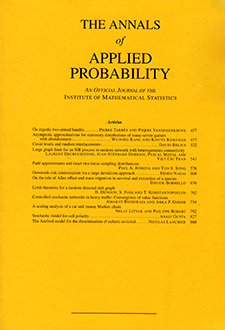Abstract
In this paper, we introduce a one-dimensional model of particles performing independent random walks, where only pairs of particles can produce offspring (“cooperative branching”), and particles that land on an occupied site merge with the particle present on that site (“coalescence”). We show that the system undergoes a phase transition as the branching rate is increased. For small branching rates, the upper invariant law is trivial, and the process started with finitely many particles a.s. ends up with a single particle. Both statements are not true for high branching rates. An interesting feature of the process is that the spectral gap is zero even for low branching rates. Indeed, if the branching rate is small enough, then we show that for the process started in the fully occupied state, the particle density decays as one over the square root of time, and the same is true for the decay of the probability that the process still has more than one particle at a later time if it started with two particles.
Citation
Anja Sturm. Jan M. Swart. "A particle system with cooperative branching and coalescence." Ann. Appl. Probab. 25 (3) 1616 - 1649, June 2015. https://doi.org/10.1214/14-AAP1032
Information





